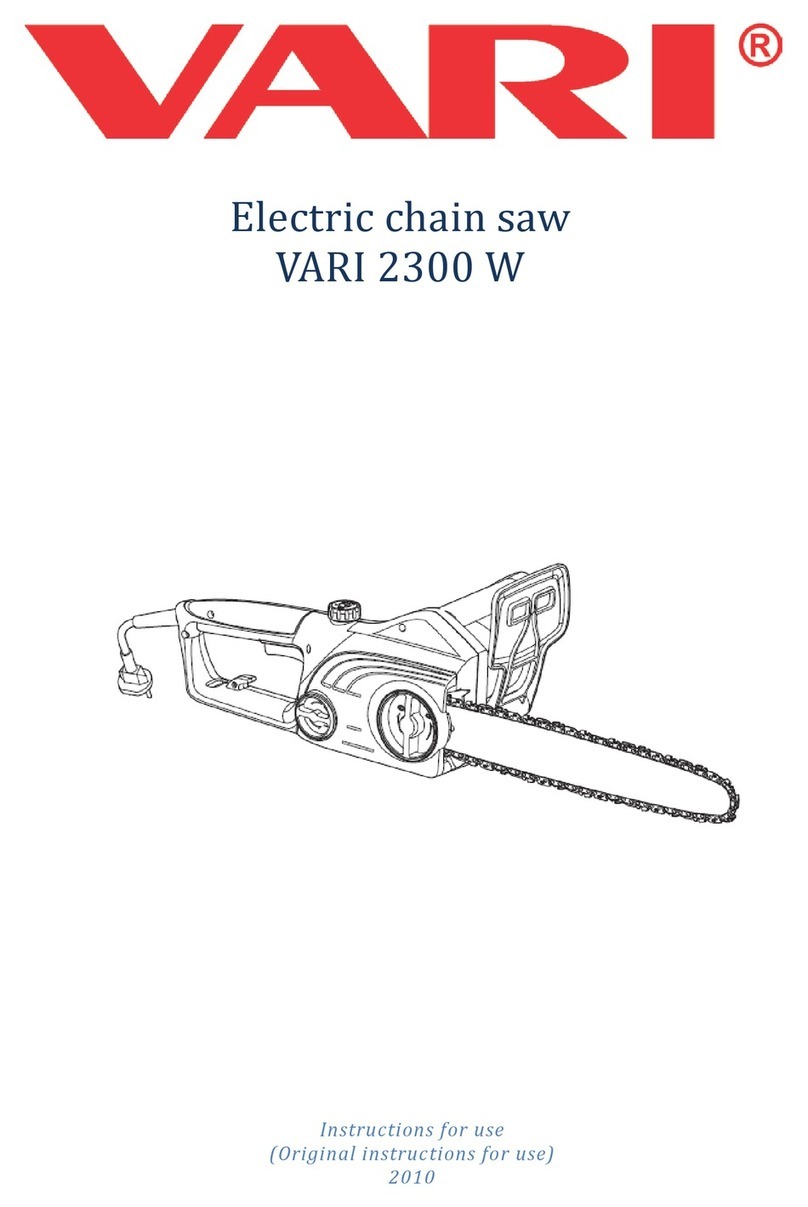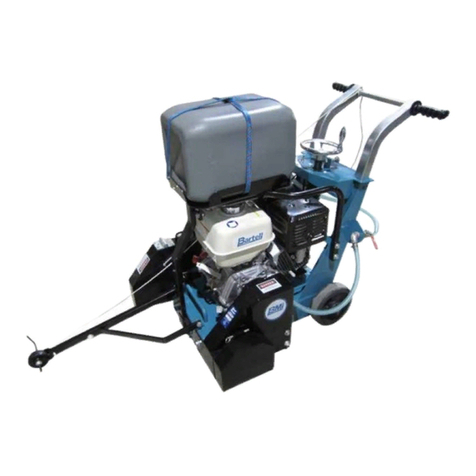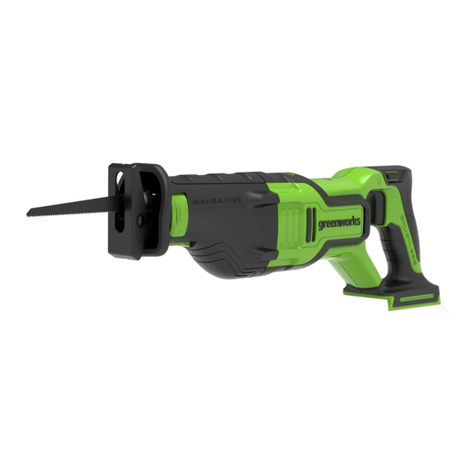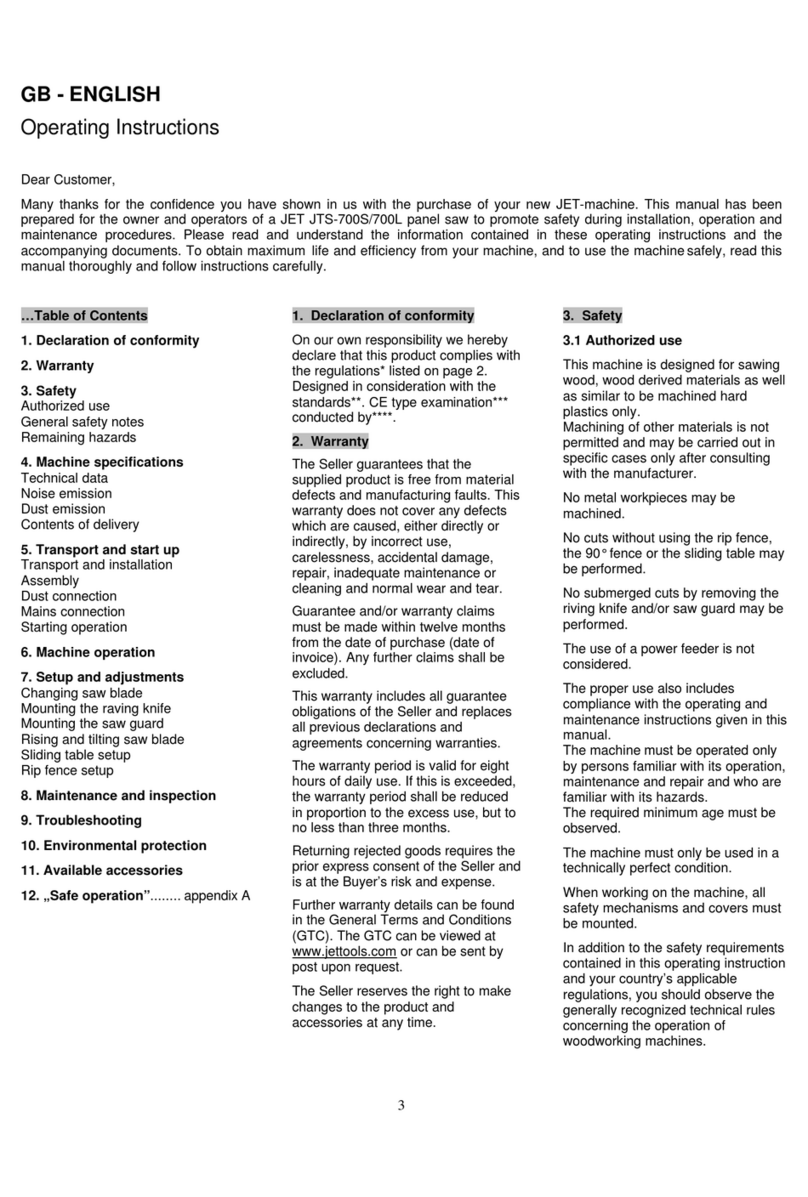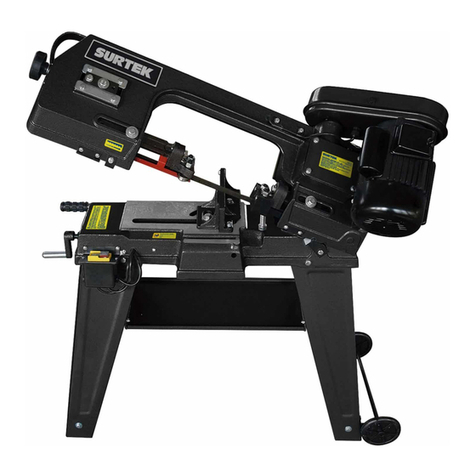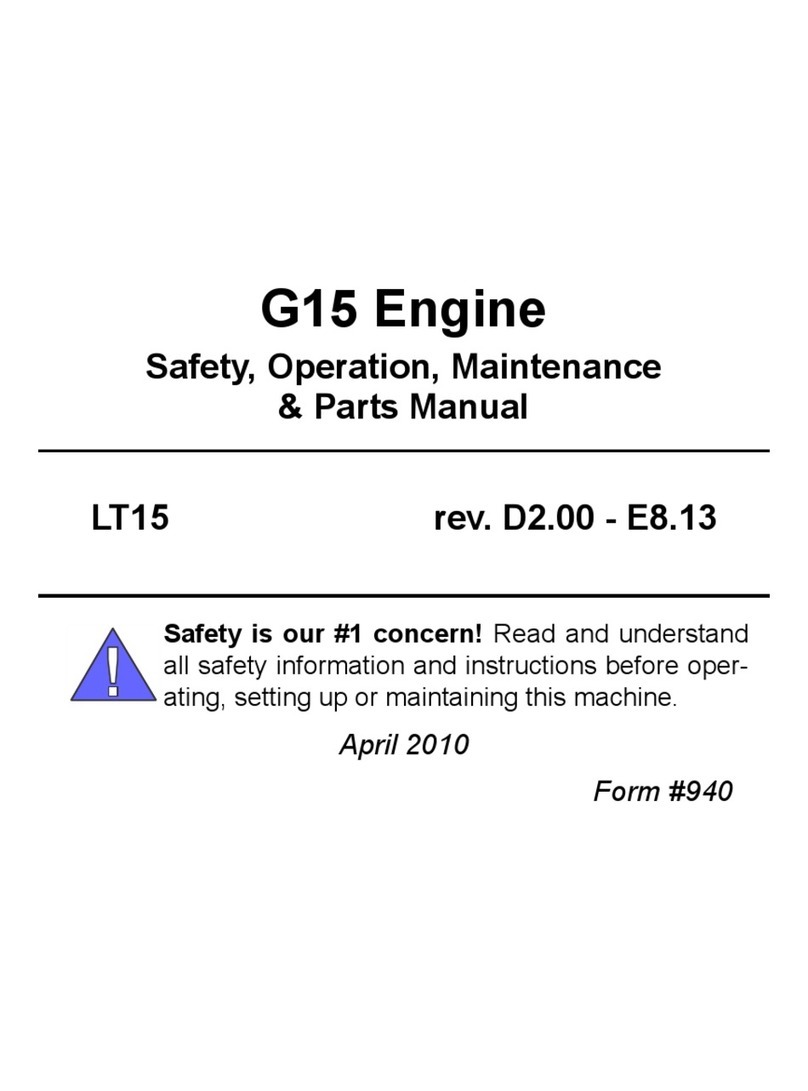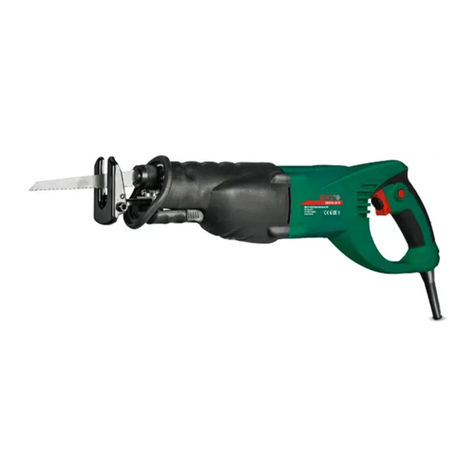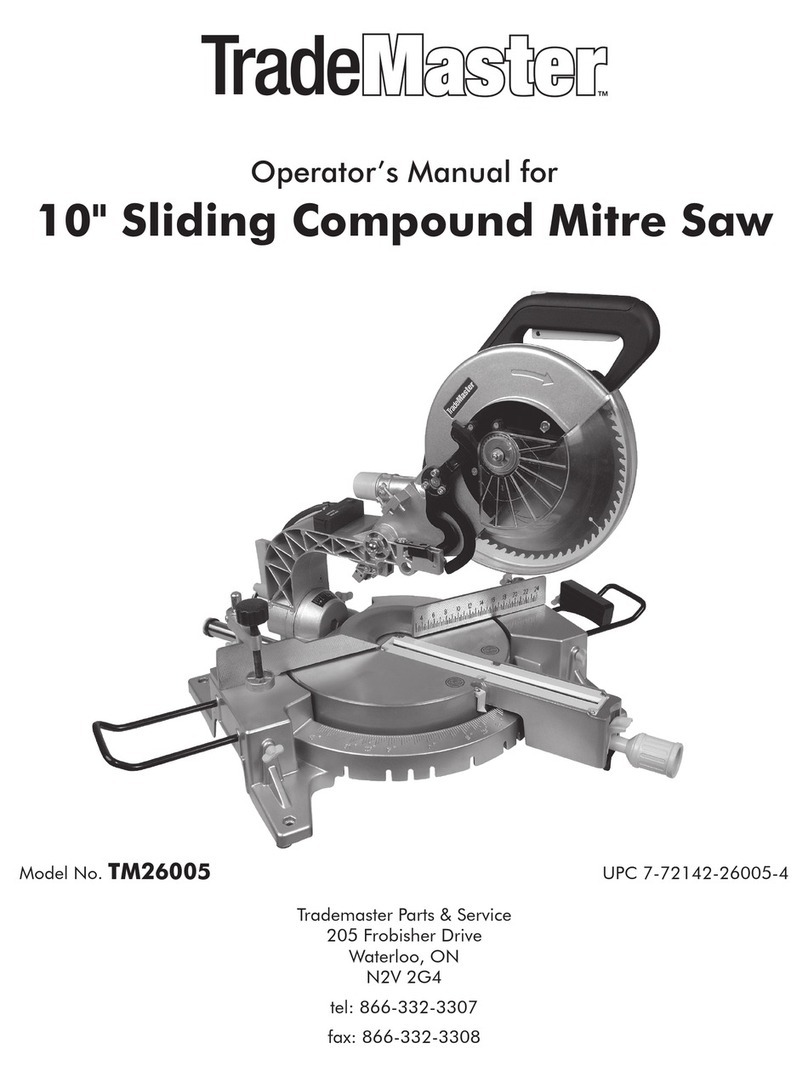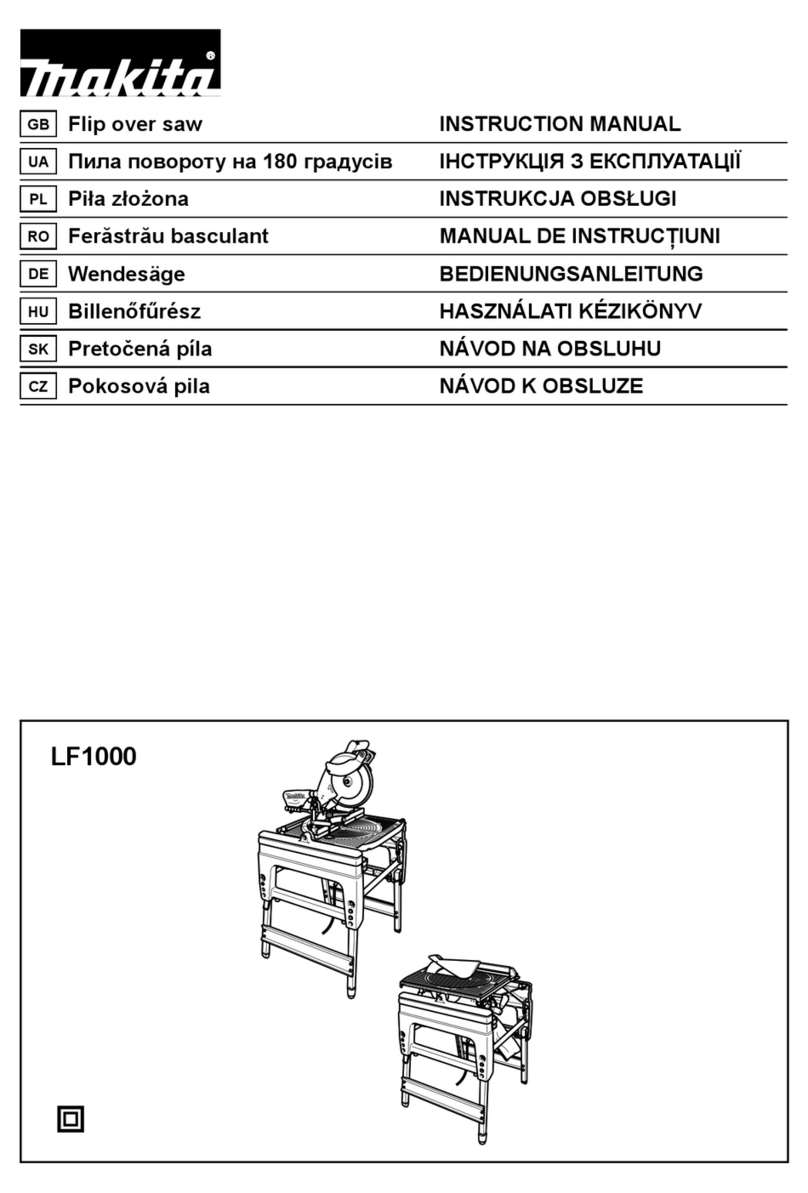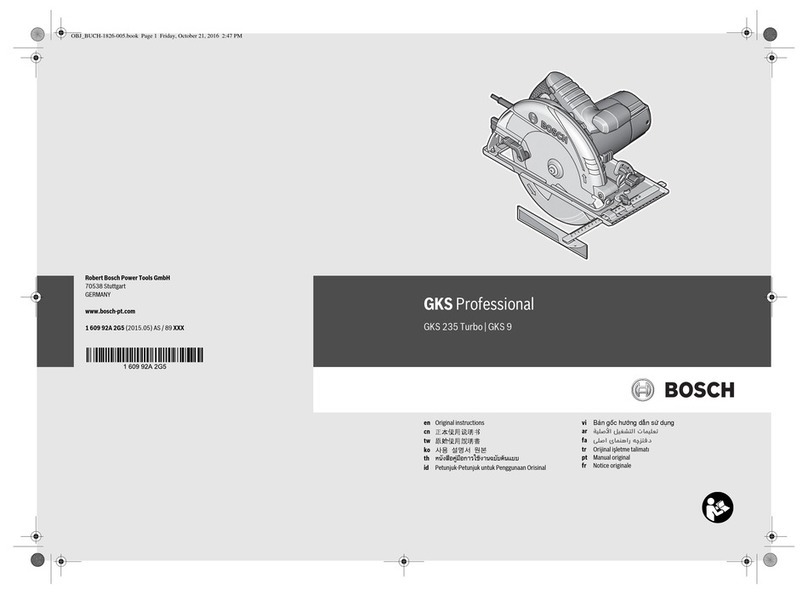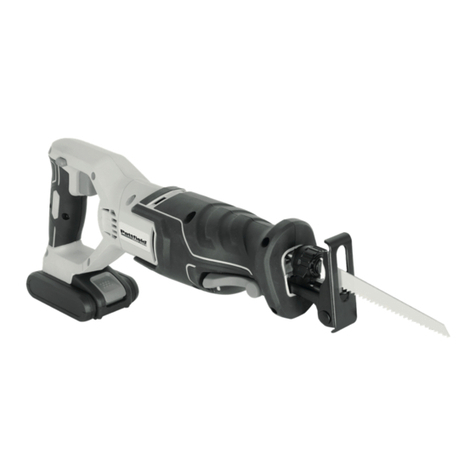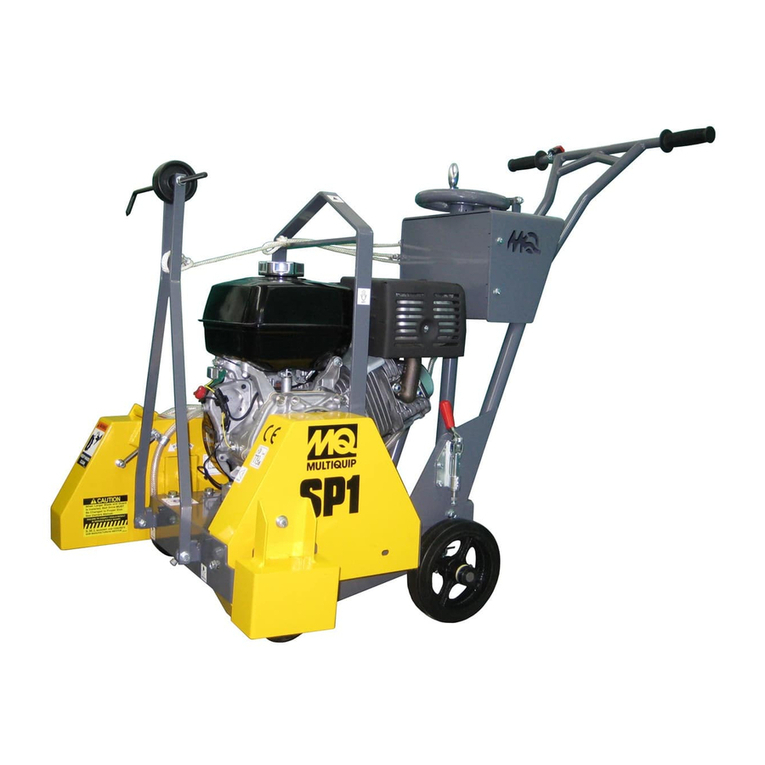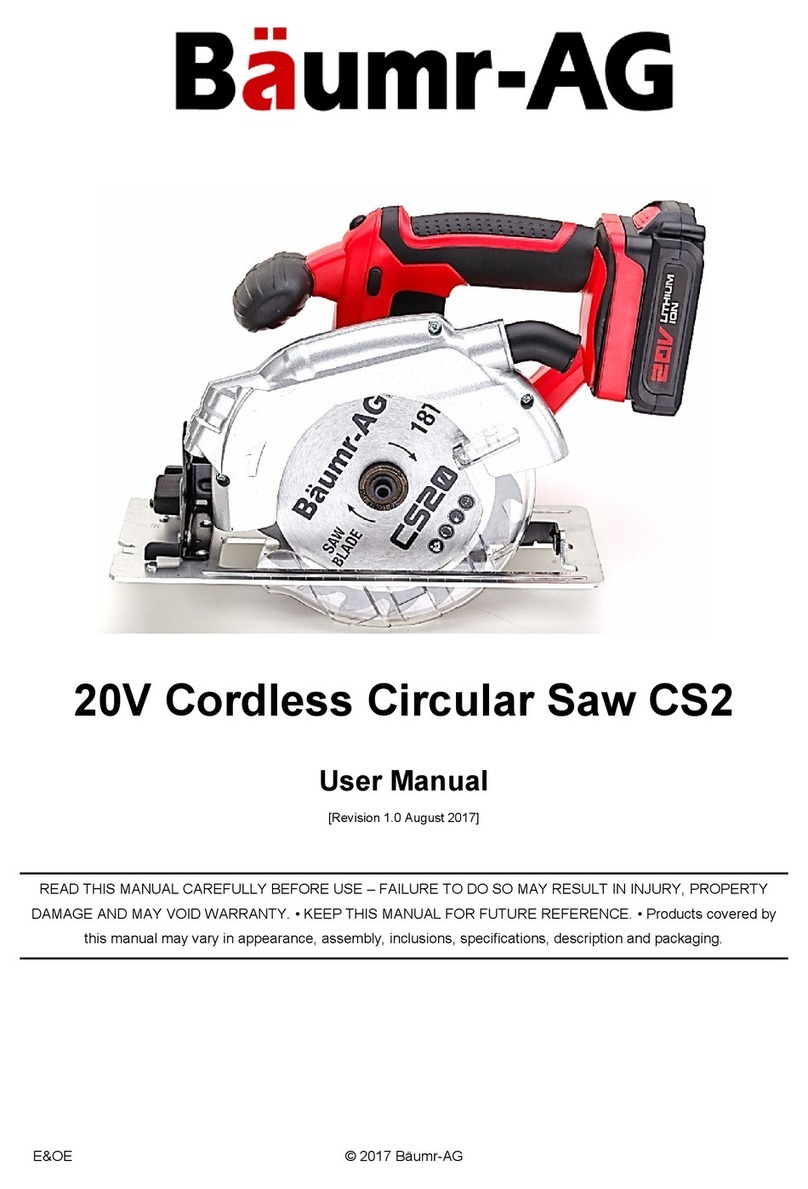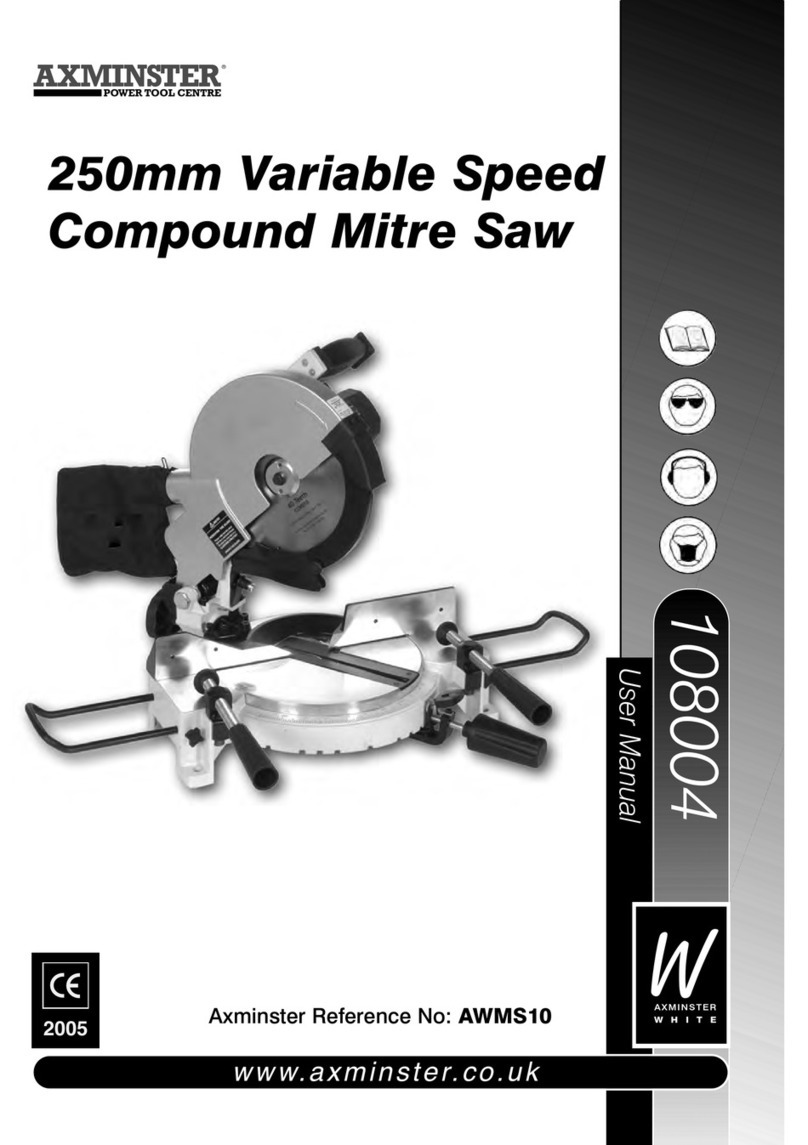Bewo CPO 315 User manual

05-01-2004 CPO 315 & 350 Page 1 / 34
Manual
CPO 315
&
CPO 350

05-01-2004 CPO 315 & 350 Page 2 / 34
Dear Customer,
We at Machinefabriek BEWO take great pride in the manufacture of the CPO sawing machines
and are confident that you will enjoy efficient productive Service for many years.
We kindly request you to return the warranty certificate you find in the back of the manual as soon
as possible. In case we do not have the warranty certificate in our possession, we can not grant
any warranty.
With kind regards,
Machinefabriek Bewo b.v.
P.O. box 5059
5004 EB Tilburg
The Netherlands
Website: www.bewo.nl

05-01-2004 CPO 315 & 350 Page 3 / 34
Table of contents
Page
Dear Customer 2
EC-Declaration of conformity for machinery 4
1 Introduction 5
1.1 General......................................................................................................................... 5
1.2 Safety regulations.........................................................................................................5
1.3 Guarantee..................................................................................................................... 7
2 Technical data 7
2.1 Main groups.................................................................................................................. 7
2.2 Survey and sketch of dimensions................................................................................. 7
3 Description of machine 8
4 Installation 8
4.1 Installation and mounting.............................................................................................. 8
4.2 Non-recurrent adjustments ........................................................................................... 9
4.3 Coolant ......................................................................................................................... 9
4.4 Electricity ...................................................................................................................... 9
4.5 Compressed air ............................................................................................................ 9
5 Operation 10
5.1 Selection of the saw blade.......................................................................................... 10
5.2 Selection of pitch and tooth form ................................................................................10
5.3 Sawing capacity.......................................................................................................... 11
5.4 Installing and replacing the saw blade........................................................................12
5.5 Saw feed..................................................................................................................... 12
5.6 Saw speed..................................................................................................................12
5.7 Clamping the material................................................................................................. 13
5.8 Cooling........................................................................................................................ 13
5.9 Start/stop .................................................................................................................... 13
6 Maintenance 14
6.1 General....................................................................................................................... 14
6.2 Lubrication .................................................................................................................. 14
6.3 Grinding the saw blades ............................................................................................. 14
Troubleshooting 15
Lubrication and coolant supplies 16
Overview of the available saw blades 16
Providing spare parts 17
Parts lists ever since page 17
Electric diagram 33

05-01-2004 CPO 315 & 350 Page 4 / 34
EC DECLARATION OF CONFORMITY FOR MACHINERY
(Directive 89/392/EEC, Annex II, sub A)
Manufacturer: Machinefabriek Bewo bv
Adress : de Kroonstraat 15
5048 AP Tilburg
The Netherlands
Herewith declares that
Machinetype : CPO 315 / 350 LT / HT
Serial number : _______________________
Year of building : _______________________
is in conformity with the provisions of the Machinery Directive (Directive 89/392/EEC), as
amended, and with national implementing legislation
The Netherlands : _______________________
C.A.M. van de Wouw
Managing Director

05-01-2004 CPO 315 & 350 Page 5 / 34
1 Introduction
1.1. General
By means of this operator’s manual you can get acquainted with your circular sawing
machine from the range CPO 315 and/or CPO 350
We advise you to read the enclosed operator’s manual carefully, so that you will soon be
familiar with the operation and maintenance of the machine. This will minimize the times of
‘downtime’.
We also ask you to pay special attention to the safety aspect that will be dealt with in chapter
1.2.
Should any unexpected malfunctions occur, which can not be remedied by means of the
instructions given in this operator’s manual, please apply to your nearest sales outlet.
1.2 Safety regulations
•Read this manual carefully, in order to get thoroughly acquainted with the operation of your
machine.
•Secure the machine to the floor.
•The floor on which is the machine is secured, must be flat and riged.
•Prevent unwanted starting of the machine. See to it that the speed selector switch is in the
Off postions while the machine is being connected.
•Provide a sufficient grounding of the machine.
•Avoid dangerous working conditions. Do not use the machine in a damp or wet environment.
•NEVER work without a safety guard.
•Wear safety goggles. Do not work with trailing pieces of clothing which could
be caught by moving parts. Preferably wear ear mufflers.
•In case of danger resulting from defects, immediately contact the person in charge of the
machine.
•Support long workpieces. Your machine can easily be extended with Bewo roller conveyors.
•Do not saw workpieces larger than those for which the machine was designed.
•Before sawing clamp the workpiece tightly.
•Do not saw with excessive pressure on the saw blade. This can cause breakage of the saw
blade.
•Replace worn or damaged parts in time and do not work with blunt saw blades.

05-01-2004 CPO 315 & 350 Page 6 / 34
Comply with the lubricating instructions and keep the machine clean.
•Use original Bewo spare parts and accessories only.
•Disconnect the mains while carrying out repairs or replacing parts.
•Make sure the saw blade is not resting on the material when the machine is
switched on.
•HAVE YOUR MACHINE INSTALLED BY AN AUTHORIZED INSTALLER!!

05-01-2004 CPO 315 & 350 Page 7 / 34
1.3 Guarantee
Defects to goods delivered of which can be proved that they have occurred within 6 months
of delivery as a result of an incorrectness in the design or of faulty finish or use of bad
materials will be repaired by us free of charge.
Claims about externally noticeable faults are to be put in at the time of testing or inspection in
our factory resp. at the latest, or in case no test or inspection takes place in our factory,
within two weeks after reception of the goods. If this period is exceeded all claims relating to
the faults concerned will expire.
Claims about faults which are not externally noticeable are to put in as soon as possible,
however, not later than two weeks after expiry of the period of guarantee. If this period is
exceeded all claims relating to the faults concerned will expire.
The purchaser’s appeal for guarantee does not relinquish his contractual obligations towards
us. As long as the purchaser does not fulfil his contractual obligations towards us we deny
our obligation to render guarantee.
2 Technical data
2.1 Main groups
The 315 and 350 range comprises models as follows:
CPO 315 LT > Low speed > sawing speed pos. 1: 18,5 m/min in pos. 2: 37
CPO 315 HT > High speed > sawing speed pos. 1: 37 m/min in pos. 2: 74
CPO 350 LT > Low speed > sawing speed pos. 1: 20,5 m/min in pos. 2: 41
CPO 350 HT > High speed > sawing speed pos. 1: 41 m/min in pos. 2: 82
2.2 Survey and sketch of dimensions (see fig. 2.01)
Dimensions and weight of the machine
These are similar before LT and HT execution.
CPO 315
Height: 1750 mm
breadth: 555 mm
Depth: 970 mm
Weight: 187 kg
CPO 350
Height: 1750 mm
Breadth: 555 mm
Depth: 970 mm
Weight: 197 kg
Fig 2.01

05-01-2004 CPO 315 & 350 Page 8 / 34
3. Description of machine
The 315 & 350 program consists of 4 models which have the same basic construction and
each of which meets the same high quality requirements.
The constructive differences apply to the application and the specific wishes of the user.
All versions are standardly equipped with a machine base with incorporated cutting oil tank
and pump.
All versions are fitted with a tolerance-free long-life worm and worm wheel. The worm gear
runs in an oil bath case and is virtually maintenance-free.
All versions are fitted with a double, self-centring material vice.
The machine can mitre, slot and cut recessed corners in both directions. For this last form of
operation it is of special importance that the saw unit as a whole can turn around its axis.
The machine can saw various profiles in various dimensions and cross-sections. A survey of
these can be found in chapter 5.3 “Sawing capacity”.
The patented protective guard opens and closes automatically. The saw blade can easily be
exchanged. The machine as standard is equipped with an adapter for the saw blade (see
technical data). If ordered a different adapter can be supplied.
4 Installation
4.1 Installation and mounting
Unpack the machine.
•Determine where the sawing machine will be placed. In doing so take into account the feed
and discharge of materials, optional built-on accessories, maintenance and repairs.
•Remove the plastic plug from the saw head (fig. 4.01 B). If so required a lifting hook M20 DIN
580 can be screwed into the hole.
•Place the saw unit - if necessary by means of hoisting equipment – on the machine base
(cover at the rear) and attach each other.
•Secure the machine to the floor. The necessary holes have already been made in the
machine base.
•Install the handle in the saw head and lock it (fig 4.01A).
•Install the 3 short handles in the boss of the machine vice.
•Install the stretcher in the clamp.
•Slide the plastic tube coming from the cooling pump onto the tap which is positioned on top
of the protective guard of the saw unit (fig 4.02A).
•Check on the level gauge of the saw head whether it contains sufficient oil. If necessary
fill up (fig. 4.01, see arrow).
•Install the cover at the rear of the machine base.
•Install the saw blade (see chapter 5.4).

05-01-2004 CPO 315 & 350 Page 9 / 34
4.2 Non-recurrent adjustment
This adjustment is concerning the LOWEST POSITION of the saw head. Follow the
instruction on the saw flange (fig. 4.03, see arrow). This instruction is also important when
changing the saw blade.
4.3 Coolant
The sawing machine can, depending on the version, be equipped with a circulation system or
with atomized lubrication.
Circulation system
Fill the tank with coolant. Use sawing coolant and absolutely NO cutting oil. Bewo
recommends Bewo Oil S, avaible from your dealer. The coolant must be diluted in waer in a
ratio between 1:10 and 1:20, depending on the kind of material. Add the oil slowly to the
water while stirring it continually. The filler cap is positioned at the rear of the machine base.
The capacity of the tank is 30 litres.
The coolant circulates and for the larger part flows back into the tank. After some time the
coolant will be used up completely and the tank will have to be filled again. A filter is also
incorporated in the coolant circuit.
4.4 Electricity
Have the electrical connections made by a qualified installer. Connect the machine in
accordance with the electrical diagram applying to your machine.
Saw motor
Two-speed pole changing motors are suitable for one mains voltage only. Therefore check
whether the voltage indicated on the motor plate complies with the local mains voltage.
Check whether the direction of rotation of the saw spindle corresponds to the arrow
on the safety guard.
If the motor rotates in the wrong direction two phases wires must be switched.
5 Operation
5.1 Selection of the sawblade
Fig 4.01 Fig 4.03Fig 4.02

05-01-2004 CPO 315 & 350 Page 10 / 34
After years of research we recommend you to use only Timewinner saw blades. These HSS
saw blades are of top quality and are made of the base material DMO 5. These saw blades
have undergone a special heat treatment which guarantees high wear resistance. Owing to
the microsporous structure the cutting oil is transferred quicker into the saw cut. This means
longer life before resharpening and less chance of cold welding. The quality of the saw blade
is of great importance. The selection of the correct pitch depends on the material to be sawn.
The selection of the correct pitch and rake angle is of great importance for the life of the
sawblade.
5.2 Selection of pitch and tooth form
If the pitch is too small and the length of the cut too large, the cut material cannot be taken
into the tooth cavity. The chip will get stuck in the tooth cavity, so that it is inactive in case of
a second cut of the same tooth. This can cause the saw blade to jam and break.
A pitch which is too large will cause the sawing tooth to hack as a result of which teeth can
break free. For the sawing of profiles it must be taken as a rule that at least two teeth of the
saw blade are in cut.
Fig. 5.01 will help you determine the pitch for the material to be sawn.
Hint
If a short, hard jerk is felt during sawing and the saw starts jolting, do not continue. In such
cases it is almost certain that at one or more places a fine chip has fused away at the flank of
the saw tooth. This causes the saw to be slightly thicker at certain places. Remove the saw
blade and remove the fused material with a fine-grained, high-grade saw file.
Selection of the tooth form.
Besides a well selected pitch the following factors, too, are of great importance to facilitate
the correct machining of the material (fig. 5.02):

05-01-2004 CPO 315 & 350 Page 11 / 34
Clearance angle ß and rake angle y of the tooth have been selected correctly in view of the
material to be sawn.
the principle is as follows.
Material Clearance angle Rake angle
Steel
Stainless steel
Non-ferrous
8
6
12
22°
15°
25°
Form of tooth cavity large enough compared to the pitch.
A quick removal of the cut material and a correct depth and rounding of the tooth cavity are
of the utmost importance. The tooth cavity must be large enough for the removed chips to be
bend as long as the tooth is cutting. When the cutting tooth leaves the saw cut, the chip
drops out of the tooth cavity.
The alternate saw (alternately bevelled edge) is often used for small pitches, especially up to
4 mm.
The precutting and finishing teeth are used for larger, solid material, usually from pitch 4 mm
onwards. These teeth ensure that the chips are not all of the same length. If a chip were to
be cut out the normal way, it would get hot, expand and become wider than the width of the
cut. This would cause it to get stuck, as a result of which the chip could not be removed from
the cut. The finishing tooth must be positioned 0.2 to 0.4 mm higher than the precutting tooth.
The larger the pitch, the higher the precutting tooth must be placed as compared to the
finishing tooth.
Consequently, only special machines are suitable for regrinding these teeth. When the blade
has lost its cutting power, do not strain it. As a result the teeth may break off, which doubles
the regrinding costs.
5.3 Sawing Capacity
For the maximum capacity in mm see the schedule for the profile figure/cross-cut in
relationship with the mitre angle. Whit 90º we mean straight sawing. Use the table from the
machine type you have, CPO 315 or CPO 350
CPO
315
90º 110 100x100 100x100 100x100 140x90 55 50x50
60º 110 90x90 90x90 90x90 100x90 45 40x40
45º 110 90x90 90x90 90x90 100x90 45 40x40

05-01-2004 CPO 315 & 350 Page 12 / 34
CPO
350
90º 125 110x110 110x110 110x110 140x100 55 50x50
60º 120 100x100 100x100 100x100 120x100 45 40x40
45º 110 100x100 100x100 100x100 100x100 45 40x40
5.4 Installing and replacing the saw blade
•Set the main switch in the off position.
•Put the saw head in the upper position.
•Open the guards (fig. 5.03A).
•Release the socket head screw M8 of the saw spindle (fig.
5.03B) and remove the saw flange.
•Remove the saw blade.
•Carefully clean the saw spindle and the saw flange.
•Installing is done in reverse order. Pay attention to the direction
of rotation of the sawblade. Make sure the saw blade is placed
flush against the flange of the saw spindle. Check the setting of the sawing depth (see
chapter 4.2). Do not forget to close the safety guard.
5.5 Saw feed
Manual saw feed
The saw feed is determined by hand. The saw is lowered onto the material by means of the
handle. Press the saw blade firmly onto the material, without using unnecessary force.
When the saw pressure is too high this can cause the saw to break; when the saw pressure
is too low, te saw will rapidly go blunt.
5.6 Sawing speed
The sawspeed will be selected by the switch (fig. 5.04A)
The following cutting speeds are possible:
CPO 315 LT > speed in position 1: 18,5 m/min in pos. 2: 37
CPO 315 HT > speed in position 1: 37 m/min in pos. 2: 74
CPO 350 LT > speed in position 1: 20,5 m/min in pos. 2: 41
CPO 350 HT > speed in position 1: 41 m/min in pos. 2: 82
Every material has it’s own cutting speed. Below advice for some materials:
18,5 & 20,5 m/min > For steel alloy e.g. stainless steel
37 & 41 m/min > For normal steel
41 & 82 m/min > For non-ferrous materials
Fig. 5.04
Fig. 5.03

05-01-2004 CPO 315 & 350 Page 13 / 34
5.7 Clamping the material
It is of the utmost importance that the material is safely clamped in the double material vice,
so that it cannot tilt over or even move during sawing. In order to work efficiently, the material
must always be clamped in such a way that the contact surface of the saw and the material
is as small as possible. For instance, saw flat material on its
thinnest side; this will considerable shorten sawing times.
When very short pieces have to be sawn, and consequently
only half of the material vice will be used, in order to prevent it
from pulling out of alingment, a piece of material of equal
thickness must be clamped in the other half of the vice. In this
way the material is clamped tightly and evenly.
Application of special vice jaws is recommendable for
repetitive work
The sawing depth can be limited by means of an adjustable
ring, see chapter 4.2
Mitre-sawing
Pull the clamping rod (fig. 5.06B) to the right and turn the sawing unit in the required mitre
position. The position can be read out on the scale division (fig 5.06A). Then fasten the
clamping rod again. Do not use unnecessary force, a slight pull will suffice. Before clamping
the material, check whether the saw is running completely clear between the jaws of the
material vice. Place the steel vice jaws as closely as possible to the saw.
5.8 Cooling
Cooling is of great importance to the life of the saw blade. After thorough investigation it has
been established that the emulsifiable coolant Bewo Oil S absolutely prevents - among other
things - the forming of so-called built-ups (the fusing of cut material to the tooth point flanks).
This will prevent a jolting saw, which results in damage and breakage.
Bewo Oil S forms a lubricating film on the saw tooth points, so that, in case of increased saw
feed, the high pressure between chip and tooth (chip surface of the saw tooth) will not lead to
overheating of the saw. Here it is important that a correctly directed stream at the cutting
edges of the saw ensures an ample supply of coolant for the removal of chips and the
elimination of frictional heat.
5.9 Start/stop
•Make sure the material has been fed.
•Check the sight-glass to see whether there is sufficient oil in the saw head. If necessary top
up with BP GRXP 680 (ISO) through the vent hole in the handle.
•Check the depth setting of the saw blade.
•Check whether the vice jaws are suited for this material.
•Adjust the material vice to the material.
•Switch on the machine with the main switch.
•Select the required speed.
•Open the coolant cock on the safety guard (not in case of atomized lubrication).
•Start machine with the switch on the pulling rod.
Fig. 5.06

05-01-2004 CPO 315 & 350 Page 14 / 34
6 Maintenance
6.1 General
Clean the machine after it has been used and provide rust protection by applying a protective
oil. Regularly remove the chips which gather underneath the vice jaws. In doing so use a
thin, flat brush and NEVER an air jet.
The gears, the worm and the worm gear are subject to wear. The moment the replacement
of these parts is due, depends on the usage. You can order a complete set, including
instructions for disassembly and assembly from your dealer. This kit is available from stock.
Regularly clean the coolant tank. This will considerable lengthen the life of the pump.
Check the condition of the oil filter in the cooling circuit . If the filter is severely polluted, it
needs to be cleaned or replaced.
Check the oil level in the saw head every week.
Check the oil level of the saw feed tank and refill if necessary (see chapter 6.3).
Check the oil bowl and the water separator every day. Refill the oil bowl with BP HLP 15 or a
type of the same quality.
Remove the water from the water separator of the air unit. With the PK-versions the glass
can be screwed off.
6.2 Lubrication
The gear box with the gear parts must be rinsed clean at least once per six months,
depending on the use of the machine. Loosen the plug at the bottom of the saw head and
drain the oil. Rinse the unit with petroleum and drain it thoroughly. Fill the unit with BP GRXP
680 (ISO); the 315- and 350-series with 1.1 litre. Check the oil
level on the sight-glass. If the saw head gets too hot while used
continuously, the oil level in the saw head may be too high.
Once every three months the grease nipples of the pivots of the
saw head must be greased with a universal grease.
The 315 and 350-version has one grease nipple (fig. 6.03).
The threaded spindle, the guide rods of the material vice and the
guides of the machine bed must be oiled regularly. Use BP SHF
15 for this purpose.
6.3 Grinding the sawblades
It is only possible to work efficiently with a circular sawing machine when the saw blade is
reground in time. When the saw has lost its cutting ability, do not try to continue sawing by
pulling the handle harder, for this can cause teeth to break and the cost of regrinding
doubled.
Regrinding should only be done on special machines, constructed for this kind of work.
Besides that it is advisable to check the saw optically in your own factory after they have
been reground. In these optical checks special attention must be paid to the rake angle and
the clearance angle.
Fig. 6.03

05-01-2004 CPO 315 & 350 Page 15 / 34
Trouble shooting
Trouble Possible cause Remedy
Excessive bouncing or
breaking of the saw.
1. Speed an/or saw feed too
high.
2. Teeth blunt, tooth cavities
too small.
3. Wrong coolant
4. Saw jolts because chips
remain in the saw cavity
(cold-welding on the saw).
5. Saw installed incorrectly
with respect to the direction
of rotation.
6. Worm and worm wheel
worn out.
Use Bewo Oil S
Have the saw ground and the
tooth cavity polished, so that
the chips can easily slide
through the tooth cavity.
Turn the saw and check the
teeth.
Replace.
Motor does not trun 1. Motor incorrectly
connected.
2. Relays or motor defective.
3. Selector switch is in the
OFF position
4. Thermal protection of
motor defective
5. Fuses blown
6. Emergency stop button
depressed
Cooling system does not
work
1. Cock on saw guard in
closed position.
2. Pump incorrectly connec-
ted.
3. Pump defective
4. Cooling tank empty
5. Suction pipe of cooling
pump obstructed.

05-01-2004 CPO 315 & 350 Page 16 / 34
Lubrication/cooling agents Packing Article number
Cooling oil Bewo oil S 2 litres 34.0020
5 litres 34.0040
25 litres 34.0060
Gear box oil BP GRXP 680 2 litres 34.0100
Hydraulic oil BP BARTRAN 15 2,5 litres 34.0170
5 litres 34.0280
Survey of available saw blades
Saw blades HSS DMO5, steam passivated
Material Dim. (mm) Pitch Article number
Steel 250x2x32 3/240 teeth 32.0305
250x2x32 4/200 teeth 32.0310
250x2x32 5/160 teeth 32.0315
250x2x32 6/128 teeth 32.0320
250x2x32 8/100 teeth 32.0330
250x2x32 10/72 teeth 32.0340
250x2x32 12/60 teeth 32.0342
Stainless steel 250x2x32 3/240 teeth 32.0400
250x2x32 4/200 teeth 32.0405
250x2x32 5/160 teeth 32.0410
250x2x32 6/128 teeth 32.0412
250x2x32 8/100 teeth 32.0415
250x2x32 10/72 teeth 32.0425
250x2x32 12/60 teeth 32.0427
Steel 315x2,5x40 3/320 teeth 32.0775
315x2,5x40 4/250 teeth 32.0780
315x2,5x40 5/200 teeth 32.0785
315x2,5x40 6/160 teeth 32.0790
315x2,5x40 8/120 teeth 32.0800
315x2,5x40 10/100 teeth 32.0810
315x2,5x40 12/80 teeth 32.0820
315x2,5x40 15/60 teeth 32.0830
Stainless steel 315x2,5x40 3/320 teeth 32.0855
315x2,5x40 4/250 teeth 32.0860
315x2,5x40 5/200 teeth 32.0865
315x2,5x40 6/160 teeth 32.0870
315x2,5x40 8/120 teeth 32.0880
315x2,5x40 10/100 teeth 32.0885
315x2,5x40 12/80 teeth 32.0890
315x2,5x40 15/60 teeth 32.0895

05-01-2004 CPO 315 & 350 Page 17 / 34
Available on request:
- Special saw blades for aluminium, brass and cupper
- Saw blades with a diameter of 350 mm
Ordering spare parts
Direct your orders to your dealer only.
In order to process your orders in the quickest way possible, we ask you to state the necessary
information on your order.
On the next pages you will find the spare parts lists and drawings for finding the article numbers
you like to order.
Your order must contain the following information:
Type of machine.........................................................................................
Mains voltage................................................................................................
Year ofconstruction....................................................................................
Description spare part................................................................................
Quantity required…....................................................................................
Article number…..........................................................................................
Besides spare parts you can also order coolant and saw blades.
Parts lists

05-01-2004 CPO 315 & 350 Page 18 / 34

05-01-2004 CPO 315 & 350 Page 19 / 34
Group 100 PEDESTAL Quantityl per machine
Pos.nr. Description Part nr. 315 350
101 Pedestal 60.4350 1 1
102 cover 50.9806 1 1
103 Support pump 50.9805 1 1
104 Screw M6x12 44.1332 4 4
105 Spring washer 6 44.2452 6 6
106 Screw M10x100 44.1187 2 2
107 Screw M8x16 44.1362 2 2
108 Spring washer 8 44.2454 2 2
109 Sticker electro 48.3700 1 1
110 Sticker Bewo general 48.0021 1 1
111 Pump set 230/400V 50 HZ 65.2267 1 1
113 Screw M6x25 44.1335 2 2
*) Pump set contents:
111 A Pump 91.0500 1 1
111 B Hose 2 m 22.7052 1 1

05-01-2004 CPO 315 & 350 Page 20 / 34
This manual suits for next models
2
Table of contents
